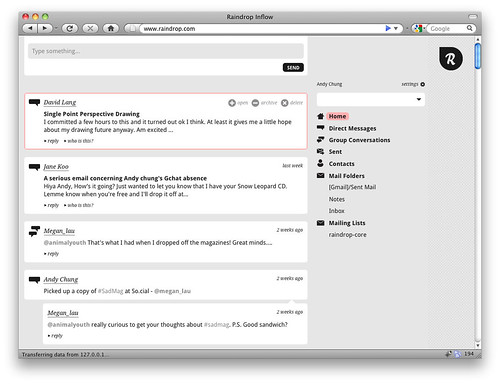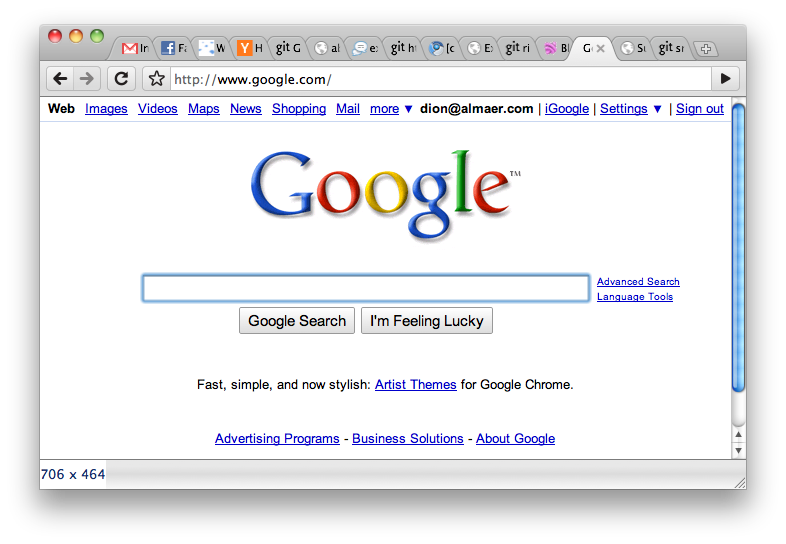
The first couple of weeks at Palm have been a whirlwind. We wanted to get a developer program out there, and it happened in short order! Add to that the fact that I had the fortune to see a beautiful new son come into this world. Phew. I need to get my breath back.
Ben and I were incredibly excited to be able to come out with a program that gives a glimpse of our vision. In a kick-off event at the Mighty club, we got to share the vision, along with the details. For the nuts and bolts read here, but for some thoughts on the vision and key elements, read on:
We told the story of why we are so excited about Palm and the mobile Web as a-whole right now. It feels like there is a real convergence happening between: the fact that the mobile device hardware has become the hitchhikers guide to the galaxy, or so it feels; and knowing that browser runtimes have finally become application runtimes. There is a lot of room for both of these technologies to grow, but we have reached a good place already. What’s now happening is that we’re bumping up against the browser sandbox like crazy and we’re all trying to expand out what’s possible on the web. We’re doing this because for all its warts, many of us see in the web the potential to be The Platform that we can use across all of these emerging devices to bring sanity to application development. Imagine a world where you can develop Web applications that you can deploy to a plethora of devices and form factors. We have a real opportunity to make this world a reality, and it will take the entire Web community to make this happen.
What about the program itself?
We announced tonight that we’ve decided to free developers to release and market their applications via the web. When you decide to release your app, it is assigned a URL that you can distribute any way you like. With that URL, the user can install the application on the device. With this mechanism, you skip any review process and get a direct conduit to your users.
But for those who want the catalog experience, we’re investing heavily in the creation of a fantastic application marketplace–one that we carefully manage and organize, and where we review each application. There’s so much innovation that can happen here in terms of providing promotional opportunities for your applications and in making them discoverable, and we’re thrilled to be playing in this space.
We going to charge $50 for each app you submit to this catalog, recognizing its value as a distribution channel and as a friction point to control the flow of apps into it.
We actually want the web to win for distribution. We want to see people innovate in marketing their applications themselves and solving the app discovery problem.
To facilitate that discovery, we’re making raw feeds of all the applications available to help you create your own catalogs of applications. We can’t wait to see what people come up with here, and we’re confident the result will strengthen the app ecosystem.
Open source developer program
Almost every line of code I have written for the last 4 years or so has been open source. The Web itself stands on the shoulders of open source (Mozilla, WebKit, Apache, Dojo, jQuery, etc) and it only felt right that we should have a program for open source developers and projects. If your webOS application is released under open source, the $99 program fee is waived.
This is just the beginning. We are hopeful that a vibrant open source community will grow around the mobile Web and Palm. I would love to see tools and services that help make this happen.
The feedback that we have already gotten has been fantastic. We have gotten great ideas on what we should be doing with the platform itself as well as the program. Not that a vision is set, it is time to build on today’s actions by continuously making good decisions for the community. When Palm brought Ben and I into the fold, they indirectly brought in the Web community that we love to be a part of.
Ok, I have gotten little sleep due to a lovely new baby, and a fantastic new opportunity at work. Now it is time to close the laptop, rest up, and work with you to create some kick arse Web apps for devices.
I want to thank the hard work of my new colleagues at Palm who made this happen in short order, and also the great crowd of Web hackers who came together to help make tonight such a fun event. I can’t wait for the next one, and to keep talking.
What do you want to see from us next? Also, if you are excited about the mobile Web and what we are doing, our group is hiring fast and we would love to have passionate advocates who love the technology as well as working with all kinds of developers!



